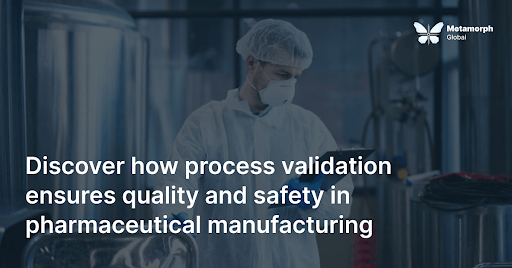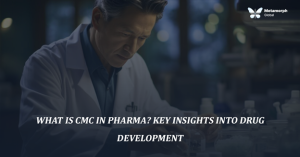Process validation serves as a cornerstone in the pharmaceutical industry, ensuring that products consistently meet the highest standards of quality, safety, and efficacy. As pharmaceutical manufacturing becomes increasingly complex, maintaining rigorous and reliable production processes is essential.
The U.S. Food and Drug Administration (FDA) has been instrumental in shaping process validation practice. Over the years, these guidelines have evolved to incorporate risk management, technological innovations, and a risk-based approach to quality systems. This ensures that pharmaceutical companies are equipped to address the complexities of contemporary manufacturing, promoting continuous improvement and a data-driven approach throughout the product lifecycle.
Let’s explore the multifaceted aspects of process validation, its stages, principles, and the essential role it plays in safeguarding public health and patient care.
What is Process Validation in Pharma?
The U.S. Food and Drug Administration (FDA) defines process validation as:
“The collection and evaluation of data, from the process design stage through commercial production, which establishes scientific evidence that a process is capable of consistently delivering a quality product.”
This definition highlights the critical role of data-driven decision-making throughout the entire product lifecycle, from initial design to commercial manufacturing and beyond.
Key Elements of Process Validation in pharma include:
- Lifecycle Approach:
Process validation adopts a lifecycle approach, emphasizing continuous monitoring and control throughout the manufacturing process. This ensures that the process remains validated, even as conditions, products, or technologies evolve. - Quality Assurance:
Quality is integrated into every stage of the process, ensuring that products meet predefined standards consistently. This involves establishing comprehensive quality control measures, from material sourcing and equipment qualification to final product testing and release. - Risk Management:
Effective process validation incorporates risk management to identify and mitigate potential variations in the manufacturing process. This proactive approach helps to address uncertainties and improve process predictability, ensuring consistent product quality.
By focusing on these elements, process validation not only enhances the reliability of manufacturing processes but also supports the continuous improvement of product quality throughout its lifecycle.
Types of Process Validation in Pharmaceutical Industry
In the pharmaceutical industry, process validation ensures the consistent quality and safety of products through different approaches tailored to specific needs. Below are the four main types of process validation:
1. Prospective Validation
Also known as premarket validation, this type of validation takes place before the routine production of products for sale. It establishes the reliability of manufacturing processes through thorough testing and analysis to ensure product quality from the outset.
2. Concurrent Validation
This type of validation is conducted in exceptional circumstances where immediate patient benefits are significant. It may be used during new product launches or in urgent situations to validate processes alongside production activities.
3. Retrospective Validation
Although no longer acceptable for the manufacture of medicinal products, retrospective validation can still be applied in cases involving the manufacture of active substances. This approach examines historical data to confirm process consistency over time.
4. Revalidation
Revalidation occurs at scheduled intervals to ensure that systems and checks remain compliant with the required standards. This ongoing process helps maintain process integrity and supports continuous quality improvement.
These types of validation play a critical role in maintaining the highest standards of quality, safety, and regulatory compliance in pharmaceutical manufacturing. Learn about types of process validation in detail.
Stages of Process Validation In Pharma
Process validation is a multi-stage approach that ensures the manufacturing process consistently delivers high-quality products. The U.S. Food and Drug Administration (FDA) has played a pivotal role in shaping the Stages of Process Validation, offering “Guidance for Industry Process Validation: General Principles and Practices” that reflects the latest industry standards and technological advancements.
Process validation in pharma consists of three critical stages:
- Process Design
- Process Qualification
- Continued Process Verification
1. Process Design
Process design is the initial stage in the process validation lifecycle, where a detailed understanding of the product and manufacturing process is developed. This stage focuses on ensuring that the process can consistently produce high-quality products by identifying critical quality attributes (CQAs) and critical process parameters (CPPs).
- Objective: Develop a thorough understanding of the product, process, and customer requirements.
- Activities:
- Conducting early design experiments to assess process feasibility and performance.
- Mapping out a comprehensive process flow to visualize each manufacturing step and identify potential risks.
- Performing risk assessments to evaluate potential failure points and mitigate them through process controls.
| Activity | Purpose |
|---|---|
| Risk Assessment | Identify potential failure points. |
| Pilot Testing | Validate small-scale production feasibility. |
| Process Flow Diagrams | Map each step of manufacturing. |
Scientific principles guide the design, ensuring that each stage aligns with sound manufacturing practices. Even though cGMP standards are not enforced at this stage, adhering to scientific rigor is essential to building a robust foundation. The goal is to create a flexible and adaptable process that consistently delivers the desired product quality. By addressing risks early on, process design establishes a solid framework for the subsequent stages of validation.
2. Process Qualification
The second stage of process validation, Process Qualification, focuses on confirming that the designed process performs consistently at a commercial scale. This stage ensures that equipment, systems, and utilities operate within specified limits to meet quality standards.
- Key Activities:
- Verifying equipment calibration and functionality to ensure consistent performance.
- Conducting Process Performance Qualification (PPQ) studies to evaluate the process under production conditions.
- Utilizing statistical methods such as control charts to monitor variability and process consistency.
| Parameter | Example |
|---|---|
| Equipment Calibration | Ensuring sterility and temperature controls. |
| Sampling Plan | Collecting representative batch samples. |
| Statistical Metrics | Analyzing variability with control charts. |
During this stage, it is critical to collect and analyze data from production batches to confirm that the process can meet predefined quality criteria. Sampling plans are developed to capture representative data, ensuring the reliability of results. Statistical analysis helps identify deviations, allowing for corrective actions to be taken promptly.
Process Qualification ensures that all components of the process—equipment, personnel, and procedures—are aligned with regulatory expectations and deliver consistent product quality. This stage establishes a strong foundation for continuous process control in subsequent phases of production.
3. Continued Process Verification
Continued Process Verification (CPV) is the final stage of process validation, which ensures the process remains validated during commercial production. This stage involves ongoing monitoring, data collection, and periodic reviews to maintain the integrity of the manufacturing process.
- Best Practices:
- Implementing a data-driven monitoring program to track process performance continuously.
- Conducting periodic reviews to assess process stability and compliance with quality standards.
- Maintaining robust documentation to provide traceability and support regulatory compliance.
| Component | Purpose |
|---|---|
| Data Collection | Monitor batch quality and trends. |
| Corrective Actions | Address identified process deviations. |
| Documentation | Ensure traceability and regulatory compliance. |
Data collection plays a critical role in CPV, helping to identify trends, detect deviations, and manage process variations effectively. Through real-time monitoring, companies can ensure that their processes remain in a validated state, minimizing the risk of non-compliance and product quality issues.
Corrective actions are initiated when deviations are detected, ensuring that any issues are addressed swiftly to maintain product quality. Continuous improvement is a key focus, with regular updates and adjustments made to refine the process over time. CPV ensures that organizations sustain a reliable, high-performing process that consistently meets customer and regulatory expectations.
Regulatory Mandates and cGMP Compliance
Adherence to Current Good Manufacturing Practices (cGMP) is a cornerstone of pharmaceutical process validation. cGMP ensures that manufacturing processes are consistently applied, monitored, and maintained to safeguard the quality and safety of pharmaceutical products. Compliance with these regulations is essential for maintaining the highest standards of product quality and protecting public health.
Key cGMP Requirements:
- Written Production and Process Control Procedures: Establishing clear, documented procedures to guide every step of the manufacturing process.
- Regular Inspection and Calibration of Equipment: Ensuring that all equipment functions accurately and consistently to prevent deviations in product quality.
- Comprehensive Training for Personnel: Providing ongoing education to ensure that all personnel are well-versed in cGMP standards and their application.
- Periodic Reviews to Ensure Ongoing Compliance: Regular assessments to maintain alignment with evolving regulatory requirements and best practices.
Failure to meet cGMP standards can result in product adulteration, which poses significant risks to both the quality and safety of pharmaceutical products. Regulatory oversight enforces strict monitoring to minimize these risks. For example, Section 211.180(e) mandates continuous review of manufacturing practices to ensure consistency and adherence to standards. Additionally, sampling controls guarantee statistical confidence in batch quality, while equipment maintenance emphasizes regular calibration to prevent equipment failures.
By integrating these requirements into every stage of process validation, organizations can uphold the highest levels of compliance and product reliability.
| Mandate | Description |
|---|---|
| Section 211.180(e) | Continuous review of manufacturing practices. |
| Sampling Controls | Ensuring statistical confidence in batch quality. |
| Equipment Maintenance | Regular calibration to prevent failures. |
Statistical Methods in Process Validation
Statistical tools are essential for evaluating process variability and ensuring the reproducibility of manufacturing processes. By leveraging these methods, manufacturers can make informed, data-driven decisions that maintain quality control and consistency throughout production.
Common Techniques:
- Control Charts: Used to visually track and analyze process variations over time. They help in identifying trends and potential deviations, ensuring that processes remain within acceptable limits.
- Capability Analysis: Evaluates how well a process meets predefined quality standards by assessing its performance against established benchmarks. This method is especially useful for assessing batch uniformity and consistency.
- Regression Analysis: Establishes relationships between input variables and product outcomes, helping to identify factors that influence quality attributes and optimize the process.
These statistical methods enable manufacturers to identify areas of improvement, mitigate risks, and maintain robust process controls. For instance, control charts monitor temperature stability in the manufacturing environment, ensuring that all conditions are maintained within specified limits. Capability analysis provides insights into batch performance, while regression analysis helps link variations in input materials to their impact on product quality.
Incorporating these techniques into process validation helps ensure that every stage of production adheres to quality standards, reducing variability and promoting consistent, high-quality outcomes.
| Method | Use Case |
|---|---|
| Control Charts | Monitoring temperature stability. |
| Capability Analysis | Assessing batch uniformity. |
| Regression Analysis | Linking input variations to product outcomes. |
Incorporating these techniques into process validation helps ensure that every stage of production adheres to quality standards, reducing variability and promoting consistent, high-quality outcomes.
Challenges and Solutions in Process Validation
Process validation is a crucial aspect of pharmaceutical manufacturing, but it comes with its own set of challenges that must be addressed effectively. Here are some of the key challenges and potential solutions:
Managing Variability
- Variability in Active Pharmaceutical Ingredients (APIs) and other components can lead to inconsistent product quality. To address this, comprehensive risk assessments and the implementation of robust control strategies are essential. By identifying and mitigating potential sources of variability, manufacturers can ensure more reliable and consistent outcomes.
- Solution: Utilize statistical methods such as control charts and capability analysis to monitor and manage variability, ensuring that processes remain within acceptable quality limits.
Scaling Up
- Transitioning from small-scale production (e.g., pilot studies) to large-scale commercial production introduces new challenges, including maintaining process robustness and ensuring quality. Predictive modeling and process simulation are valuable tools to facilitate this transition.
- Solution: Predictive modeling allows manufacturers to simulate various scenarios and outcomes, helping to optimize processes before scaling. This reduces risks and ensures that processes are scalable while maintaining quality standards.
Regulatory Compliance
- Keeping up with the constantly evolving FDA guidelines and cGMP requirements can be overwhelming. Failure to comply with these standards can result in regulatory action and impact product quality.
- Solution: Regular training sessions and collaborations with regulatory experts ensure that manufacturers stay informed about the latest compliance requirements. Automated documentation systems also help maintain traceability and facilitate compliance checks.
By proactively addressing these challenges through strategic solutions, manufacturers can enhance the effectiveness of process validation, ensuring high-quality, compliant pharmaceutical products.
The Role of Technology in Process Validation
Advancements in technology have significantly transformed process validation, providing innovative tools that enhance monitoring, control, and efficiency throughout the production lifecycle:
- Automation
Automated systems streamline data collection, reducing the risk of human error and ensuring precision at every stage of the process. These systems help maintain consistency and improve overall process reliability. - Real-Time Analytics
Continuous monitoring powered by real-time analytics offers immediate insights into process performance. This allows for proactive adjustments and quick responses to any deviations, ensuring product quality remains optimal. - Digital Twins
Virtual replicas of manufacturing processes, known as digital twins, enable detailed simulations and optimizations. This technology minimizes operational disruptions while improving efficiency and reducing downtime, helping manufacturers achieve more precise control over their processes.
| Technology | Benefit |
|---|---|
| Automated Sampling | Increases efficiency and accuracy. |
| Real-Time Analytics | Facilitates proactive adjustments. |
| Digital Twins | Optimizes processes and reduces downtime. |
A Lifeline for Quality and Safety
Process validation is not merely a regulatory requirement, it is a lifeline for ensuring pharmaceutical products meet the highest standards of quality and safety. By embedding quality into every stage of the lifecycle, manufacturers can navigate complexities, mitigate risks, and uphold public trust.
To truly excel in this field, mastering statistical methods for process validation is essential. Join our Statistical Methods For Process Validation Masterclass and learn from industry experts how to refine your skills and gain the tools needed to drive excellence in pharmaceutical manufacturing. Connect Today and take your process validation journey to the next level!







